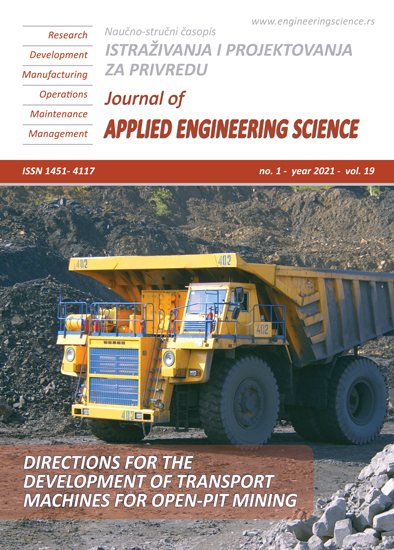INCREASING THE EFFICIENCY OF MEMBRANE TECHNOLOGIES IN WATER TREATMENT PROCESSES
Abstract
The twenty-first century is the century of the rapid development of nanotechnologies, which determine the successful dynamics of the country's economy, save energy resources, and ensure a safe ecological level of the environment. Membrane processes have rightfully occupied their niche in various areas of a number of industries. Modern technologies have made it possible to create a wide range of membranes with good mechanical, thermal and chemical properties. The range of membrane devices and installations is also diverse, which are more and more improved from year to year. Water treatment of boiler houses is a necessary process that ensures successful commissioning of technological equipment of industrial enterprises, as well as heating systems. Water treatment systems are high-cost technologies, and these costs increase annually due to annually increasing trends: an increase in tariffs for water use, deterioration of water quality indicators in sources suitable for industrial use, stricter standards for quantitative and qualitative indicators for discharged effluents, increasing quality requirements treated water used in the technological cycle.
References
Bezrukov, N., Bukhovets, E., et al. (2009). Integrated membrane technologies in water treatment: experience and implementation prospects.The III scientific-practical conference "Modern technologies of water treatment and protection of equipment from corrosion and scale formation." Moscow. Expocentre, 175 p.
Feng LIN,Shoubin ZHANG,Guoqiang MA,Liping QIU, Huajun SUN. (2018).Application of Ceramic Membrane in Water and Wastewater Treatment. E3S Web of Conferences. 3International Conference on Advances in Energy and Environment Research (ICAEER 2018), vol. 53, 4, DOI: 10.1051/e3sconf/20185304032.
Kuvardina, E. Prospects for membrane technologies for purification of multicomponent solutions: monograph. Kursk, 123 p.
Yatsun, S., Kudryavtsev, V., Kuvardina, E. (2002). On the use of a pulsed feed of a separated solution during ultrafiltration of diffusion sugar beet juice. All-Ukrainian scientific and technical journal. Vibrations in engineering and technology, no. 4 (25), 70-71.
Polivanova, T., Semicheva, N., Ryabtseva, S. (2020). Development of technology for reducing the technogenic impact of sugar factories on the environment of localities. Journal of Applied Engineering Science, vol. 18, no. 2, 238-242, DOI: 10.5937/jaes18-26301.
Dlamini, D.S., Tesha, J.M.,Vilakati, G.D., Mamba, B.B., Mishra, A.K.,Thwala, J.M., Li, J.X. (2020). A critical review of selected membrane- and powder-based adsorbents for water treatment: Sustainability and effectiveness. Journal of Cleaner Production, vol. 2, 123497, DOI:10.1016/j.jclepro.2020.123497.
Yanar, N., Kallem, P., Son, M., Park, H., Kang, S., Choi, H. (2020).A New era of water treatment technologies: 3D printing for membranes. Journal of Industrial and Engineering Chemistry, vol. 91, 1-14, DOI:10.1016/j.jiec.2020.07.043.
Zhu, Z.Z., Chen, Z., Luo, X., Zhang, W.X., Meng, S.J.,(2020). Gravity-driven biomimetic membrane (GDBM): An ecological water treatment technology for water purification in the open natural water system. Chemical Engineering Journal, vol. 399, 125650, DOI:10.1016/j.cej.2020.125650.
Cooray, T., Wei, Y.S., Zhang, J.Y., Zheng, L.B., Zhong, H.,Weragoda, S.K.,Weerasooriya, R., (2019). Drinking-Water Supply for CKDu Affected Areas of Sri Lanka, Using Nanofiltration Membrane Technology: From Laboratory to Practice. Water, vol. 11, no. 12, 2512, DOI:10.3390/w11122512.
Zhu, X.B.,Jassby, D.,(2019). Electroactive Membranes for Water Treatment: Enhanced Treatment Functionalities, Energy Considerations, and Future Challenges. Accounts of Chemical Research, vol. 52, no. 5, 1177-1186, DOI: 10.1021/acs.accounts.8b00558.
Bredikhin V.V., Akulshin A.A., Bredikhina N.V., Pereverzeva V.S. (2017). A Method of Calculating Filtration Rate of an Infiltration Water Intake in Kursk Region. Journal of Applied Engineering Science, vol. 15, no. 3, 208-211, DOI:10.5937/jaes15-14644.
Akulshin A.A., Bredikhina N.V., AkulshinAn.A., Aksenteva I.Y., Ermakova N.P.Development of Filters with Minimal Hydraulic Resistance for Underground Water Intakes. Civil Engineering Journal, vol. 6, no. 5, 919-927.

